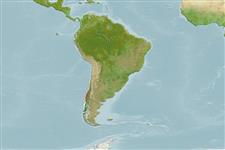Elasmobranchii (tubarões e raias) (sharks and rays) >
Rajiformes (Skates and rays) >
Arhynchobatidae (Softnose skates)
Etymology: Bathyraja: Greek, bathys = deep + Latin, raja, -ae = a ray (Raja sp) (Ref. 45335).
Environment: milieu / climate zone / intervalo de profundidade / distribution range
Ecologia
marinhas demersal; intervalo de profundidade 400 - 735 m (Ref. 127873). Subtropical
Southeast Pacific: northern Peru to central Chile.
Tamanho / Peso / Idade
Maturidade: Lm ? range ? - ? cm
Max length : 80.0 cm TL (female)
Descrição breve
Chaves de identificação | Morfologia | Morfometria
This species is distinguished by having the anterior disc margin distinctly undulating; pectoral-fin apices narrowly or abruptly rounded; preorbital length times orbital length 2.00-2.68; preorbital length times interorbital length 1.02-1.30; interorbital space times orbit length 1.20–-1.50; orbital length times spiracle length 2.00-2.53; with a median row of thorns originating from the posterior half of the disc; number of median thorns 26-30; interdorsal thorns 1 or 2; the dorsal disc surface and tail with finely textured denticles on adults confined to a narrow median band originating just posterior to mid-disc and extending along the tail; teeth arranged in quincunx; predorsal tail vertebrae 62; total predorsal vertebrae 93; pectoral-fin radial count 72. Colouration: uniformly colored on their dorsal and ventral surfaces, no blotches, spots, or other distinctive patterns which is consistent at all sizes from young to adult (Ref. 127873).
Cross section: flattened.
Oviparous (Ref. 50449). Eggs have horn-like projections on the shell (Ref. 205).
Life cycle and mating behavior
Maturidade | Reprodução | Desova | Ovos | Fecundidade | Larvas
Oviparous, paired eggs are laid. Embryos feed solely on yolk (Ref. 50449). Eggs have horn-like projections on the shell (Ref. 205).
McEachran, J.D. and K.A. Dunn, 1998. Phylogenetic analysis of skates, a morphologically conservative clade of elasmobranchs (Chondrichthyes: Rajidae). Copeia 1998(2):271-290. (Ref. 27314)
Categoria na Lista Vermelha da IUCN (Ref. 130435: Version 2025-1)
Ameaça para o homem
Harmless
Utilização humana
Ferramentas
Relatórios especiais
Descarregue XML
Fontes da internet
Estimates based on models
Preferred temperature (Ref.
123201): 7.3 - 10.6, mean 9.4 °C (based on 6 cells).
Phylogenetic diversity index (Ref.
82804): PD
50 = 0.5000 [Uniqueness, from 0.5 = low to 2.0 = high].
Bayesian length-weight: a=0.00550 (0.00291 - 0.01038), b=3.13 (2.97 - 3.29), in cm total length, based on LWR estimates for this Genus-body shape (Ref.
93245).
Nível Trófico (Ref.
69278): 3.9 ±0.7 se; based on size and trophs of closest relatives
Resiliência (Ref.
120179): Baixo, tempo mínimo de duplicação da população 4,5 - 14 anos (Fec assumed to be <100).
Fishing Vulnerability (Ref.
59153): Moderate to high vulnerability (52 of 100).
🛈
